#and appreciation for wayne family adventures character designs <3< /div>
Explore tagged Tumblr posts
Text

something something jason todd and death symbolism
#it's late and i have no thoughts but Him#and appreciation for wayne family adventures character designs <3#batman#dc comics#jason todd#red hood#jason todd fanart#my art#ghhh need to learn how to draw beefy men o(--(
203 notes
·
View notes
Text
Pathfinder Iconics Comparison Part 2: Core Classes
[Part 1: Classes with Different Iconics] [Part 3: The Remaining PF2 Classes] [Part 4: Classes Who Got Demoted] [Part 5: Prestige Classes] [Part 6: Who's left?]
The lineup of Core classes didn't change between PF1 and PF2, except that the Alchemist was promoted to Core in PF2. We've already looked at Damiel and Fumbus, the Iconic Alchemists, so let's take a look at the remaining Core classes.
In the lead-up to the launch of Pathfinder 2nd Edition, artist Wayne Reynolds did a series called Iconic Evolution with Erik Mona. He talked about his changing approach to the artwork, and the updates that he made to these characters' designs to reflect the new design philosophy of PF2. I'll be parroting bits of this throughout the post that I find the most interesting.
Note: most of these character designs predate the Pathfinder Roleplaying Game. Starting with Valeros, Seoni, Kyra and Merisiel, these characters were presented as pre-generated characters for the Pathfinder product line when it was a series of adventures for Dungeons & Dragons 3.5. Maybe at some point I'll talk about the family tree of D&D/PFRPG since it's a very interesting topic, but it's another story for another day.
Barbarian
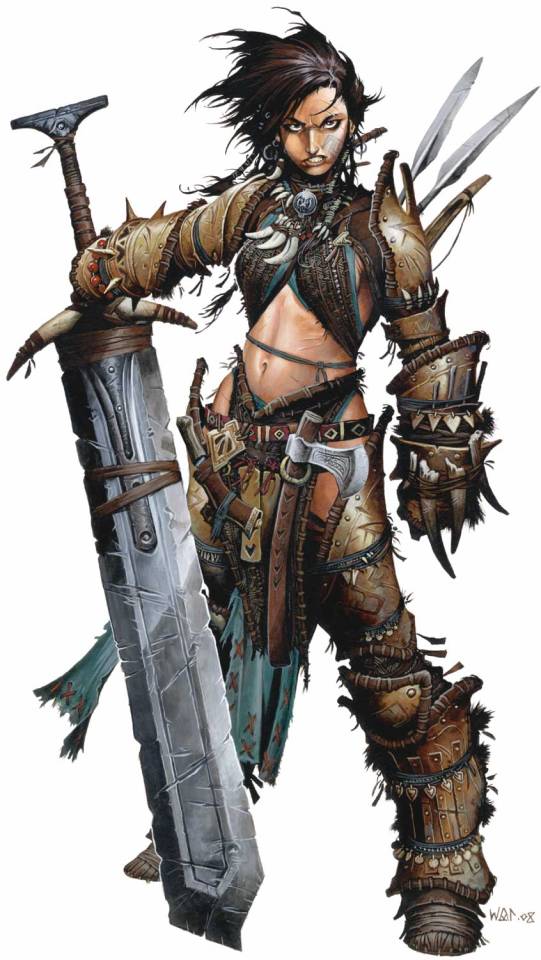

Amiri (she/her, Human [Kellid] PF1 vs. PF2)
Amiri's design changed very little. While some of the characters have covered up more, Amiri is still showing a lot of midriff since her scars are so important to her character. Her bastard sword (officially called the Ginormous Sword, not a joke) was taken from a frost giant.
Amiri was featured in Pathfinder: Kingmaker, the CRPG developed by OwlCat Games.
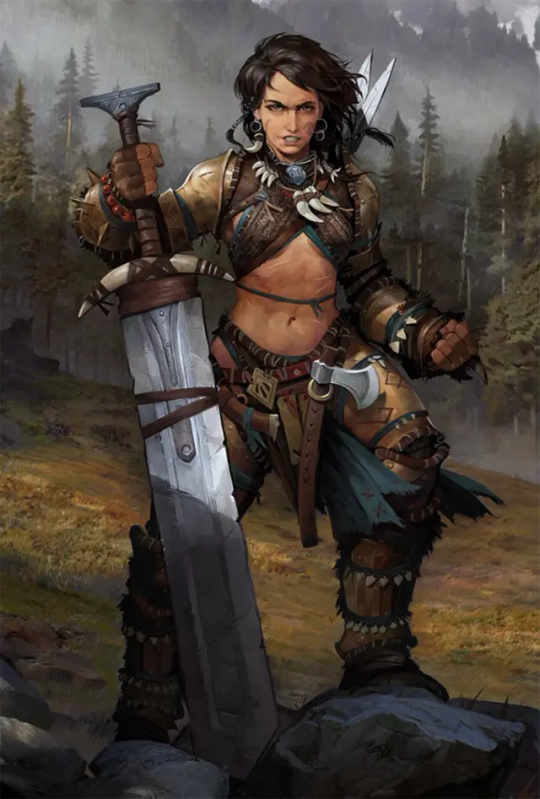
Bard
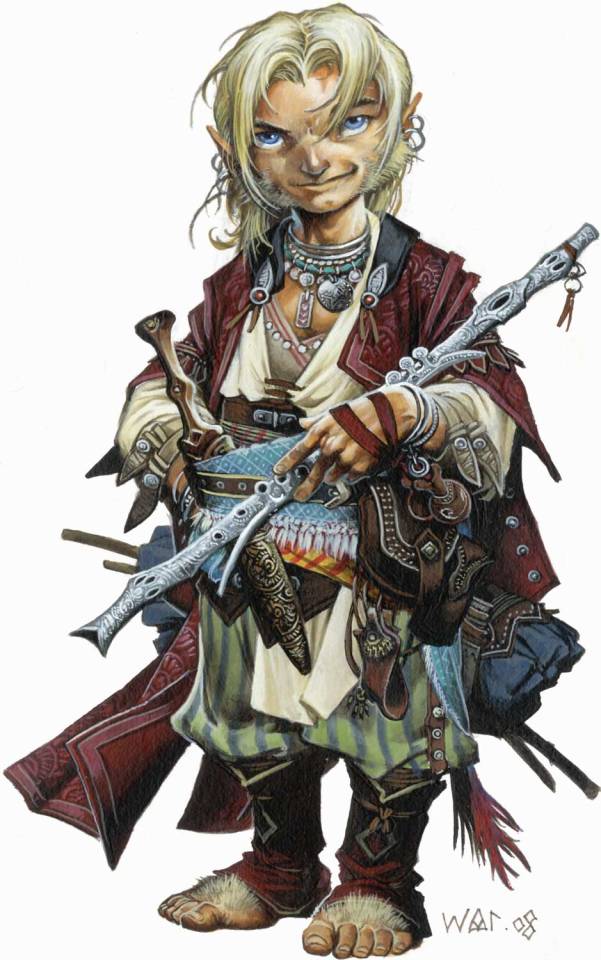

Lem (he/him, Halfling, PF1 vs. PF2)
Most of the Core Iconics are human, but there is one each of the non-human ancestries. Lem is the token Halfling. He's a member of the Pathfinder Society, and the one who inspired Ezren to join (although he refused to sponsor him). His flute is made of silver, so he can use it as a weapon against monsters that are vulnerable to silver. His design didn't change much between the two editions, but he does look a little bit older, perhaps wiser.
Wayne's design here seems to hearken back to his design for the D&D 3rd edition iconic Bard, Gimble.
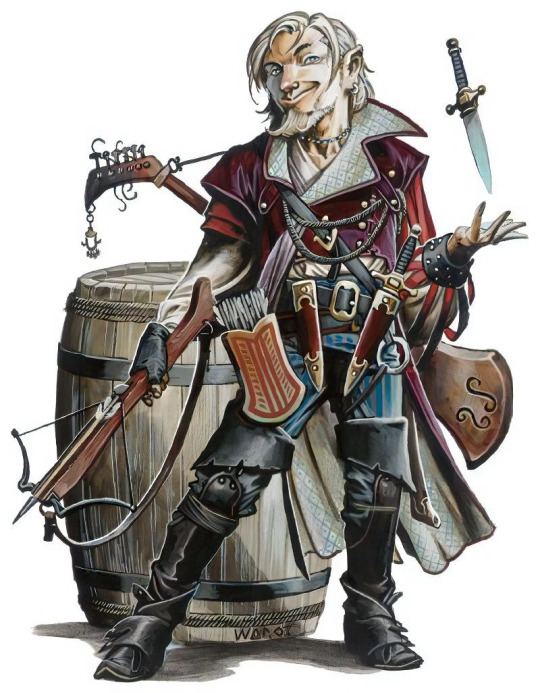
There are a few clear differences. Gimble is a gnome, for one. He's got a beard, plays a lute instead of a flute, and seems to favour a crossbow instead of a dagger, but he definitely has whispers of being a proto-Lem.
Champion (Paladin)
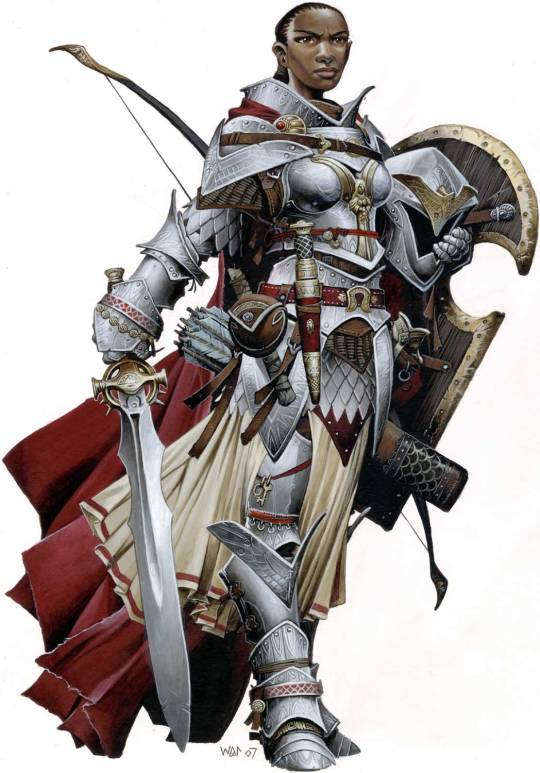

Seelah (she/her, Human [Garundi], PF1 vs. PF2)
The class was called "Paladin" in PF1 and was restricted to being Lawful Good. In PF2, the class is now called "Champion" and has been expanded to allow characters of any Good alignment, with only the Lawful Good ones being named "Paladins" (the Neutral Good Champions are named "Redeemers" and the Chaotic Good Champions are named "Liberators"). There are also Evil Champions, but that will have to wait until later.
In her PF1 design, Seelah is carrying a helmet. When she was a young street urchin, she stole that helmet from a Paladin, an act which directly led to that Paladin's death. Stricken with grief, Seelah turned to the Paladins, who raised her into a holy knight.
Like Amiri, Seelah was featured in an OwlCat CRPG, this time Pathfinder: Wrath of the Righteous.
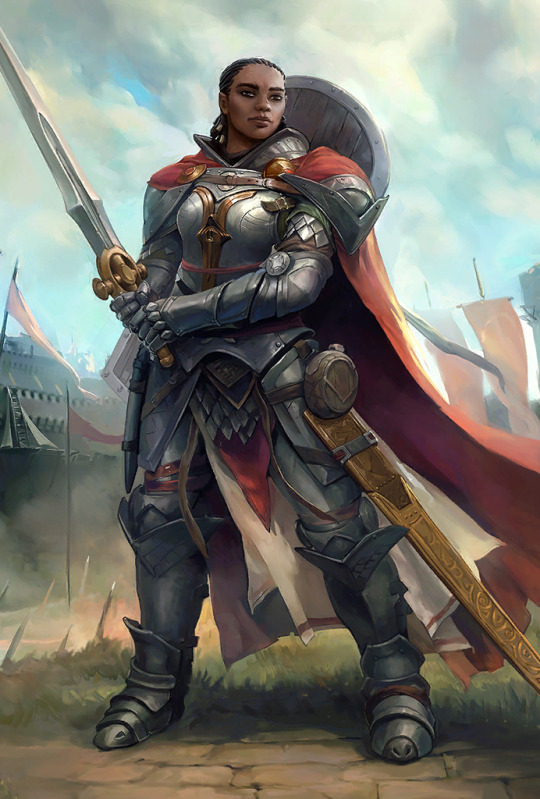
Cleric

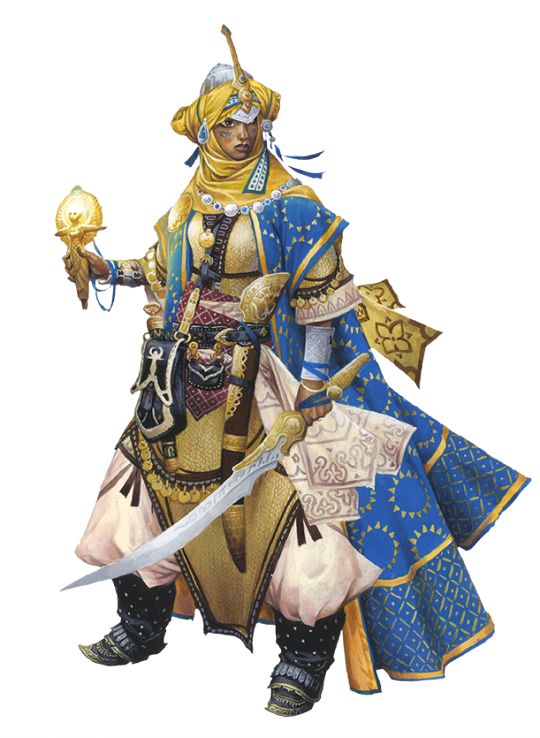
Kyra (she/her, Human [Keleshite], PF1 vs. PF2)
Kyra exemplifies something that I really enjoy about PF2 which is increased colour saturation. A lot of the PF1 illustrations are kind of muddy and washed-out, but for the most part in PF2 they're bright and vibrant. Kyra's blue and yellow outfit really pops.
Kyra is married to the Iconic Rogue, Merisiel (Kyra x Merisiel appreciation post coming soon).
Druid
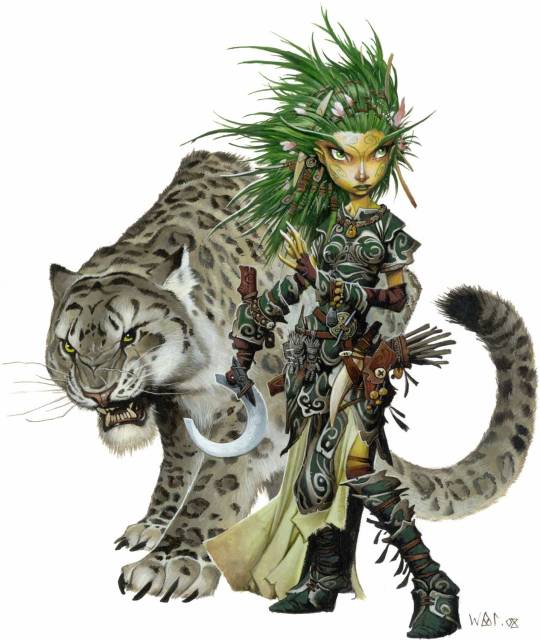

Lini & Droogami (she/her, Gnome, PF1 vs. PF2)
Lini is the second of our four token non-humans, this time representing the gnomes. With PF2, they made an effort to separate themselves from their D&D roots and do something unique with the gnomes. They tried to make gnome designs cleave closer to their fey origins than they had previously, and I think that comes across in Lini's design. The quiver on her hip carries twigs, which she collects from every forest she visits.
Fighter
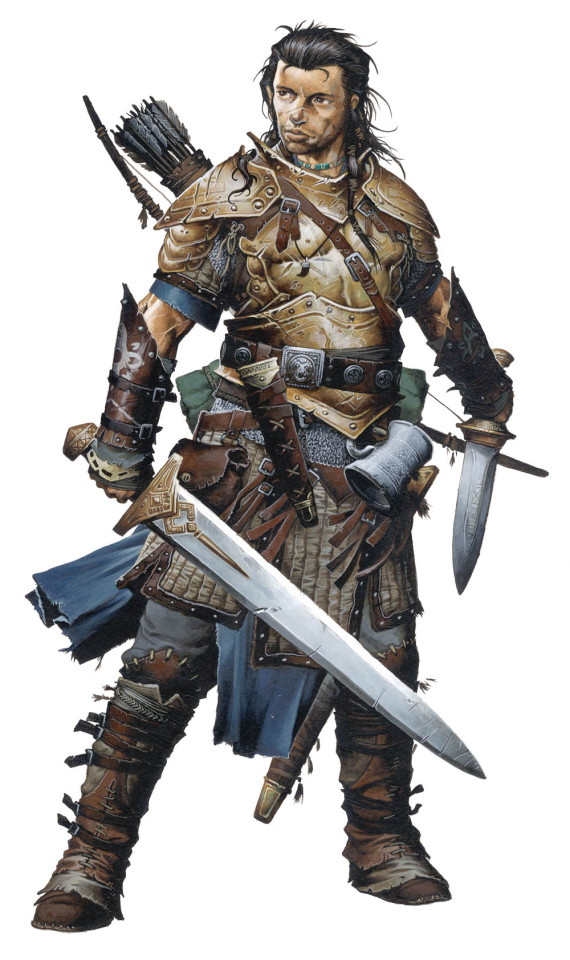
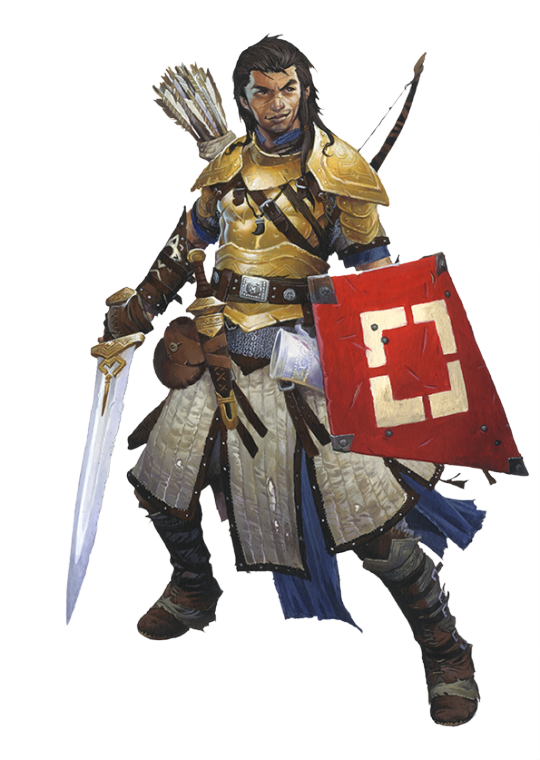
Valeros (he/him, Human [Chelaxian], PF1 vs. PF2)
Like Kyra, Valeros is looking much bolder and brighter. He's now got a shield, since shields gained increased mechanical interest in PF2. Also notice the tankard hanging from his belt. Valeros is a worshipper of Cayden Cailean, the Accidental god of ale, bravery, freedom and wine.
Valeros was the first Iconic character ever designed. Along with Seoni, Kyra and Merisiel, he appeared in D1: Crown of the Kobold King.
Monk


Sajan (he/him, Human [Vudrani], PF1 vs. PF2)
Like I said earlier, a lot of the Iconics covered up more in the transition from PF1 to PF2, and Sajan is no exception. I enjoy Sajan's PF2 iteration more not just because the blue of his clothes pops more, but it's also just such a more dynamic pose. I never particularly liked his A-pose key art, I don't feel it does a good job of showing what a Monk actually is.
Ranger
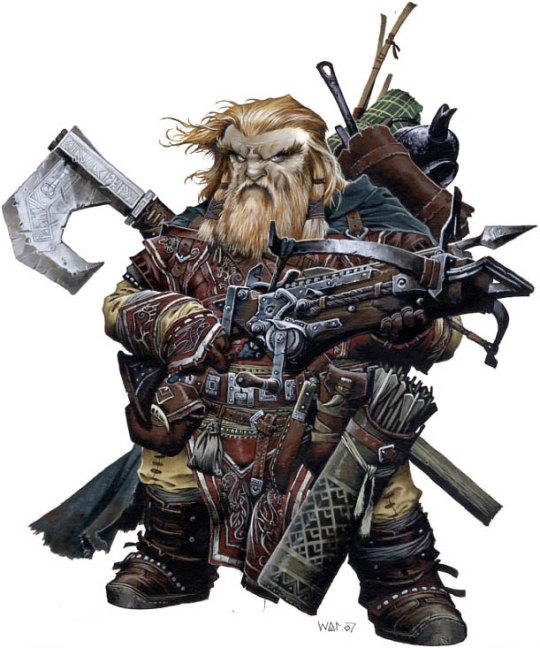
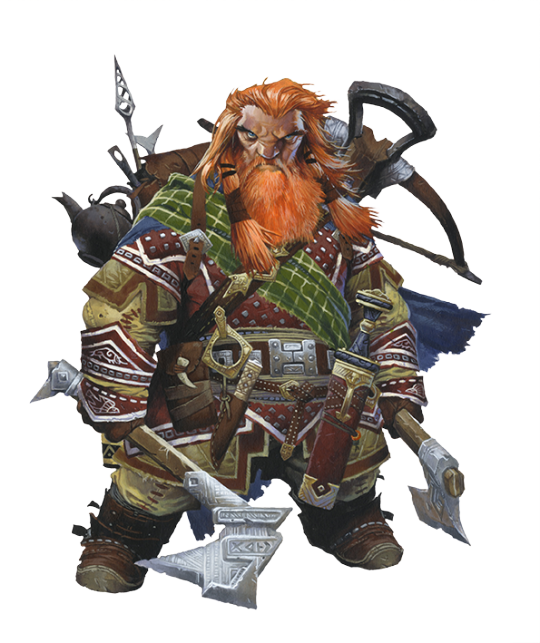
Harsk (he/him, Dwarf, PF1 vs. PF2)
The increased colour saturation really did wonders for Harsk, making his beard and tartan sash really stand out. The crossbow was his main weapon in PF1, but in PF2 they wanted to emphasise two-weapon fighting as a Ranger thing, so while they took away Valeros's off-hand weapon in exchange for a shield, Harsk now takes the role of resident dual-wielder. Notice as well that one of his most prominent accoutrements is his black tea kettle. Tea is Harsk's primary vice, man after my own heart.
Rogue

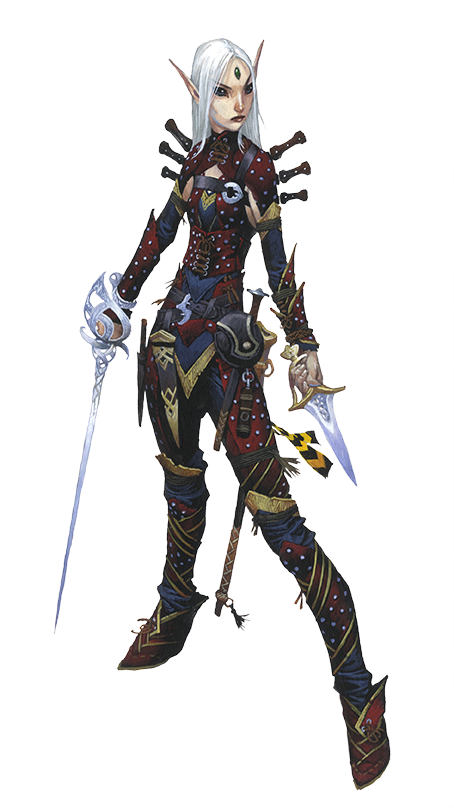
Merisiel (she/her, Elf, PF1 vs. PF2)
And now we come to the last member of the token non-human gang, Merisiel the Elf Rogue. Her outfit has remained mostly the same, though her rapier has undergone a transformation, and she seems to have swapped her throwing knives for a main-gauche. Wayne mentioned in his video that he tried to make his elves look more alien, moving away from just being "humans, but" like so many fantasy races. Merisiel is slender and waspish. Speaking of wasps, the black and yellow striped cloth is a symbol of her deity, Calistria, the Savoured Sting, god of lust, revenge and trickery.
Merisiel is Kyra's wife.
Sorcerer


Seoni (she/her, Human [Varisian], PF1 vs. PF2)
Seoni was the second character ever designed for Pathfinder.
Like Amiri, she shows off a lot of skin, because her tattoos are a big part of her character design. She got a cool new cloak though, and her staff got an upgrade (Wayne talks about the specific inspiration for this in his video). The cloak actually appears in some PF1 artwork, like her appearance on the cover of Mythic Adventures.
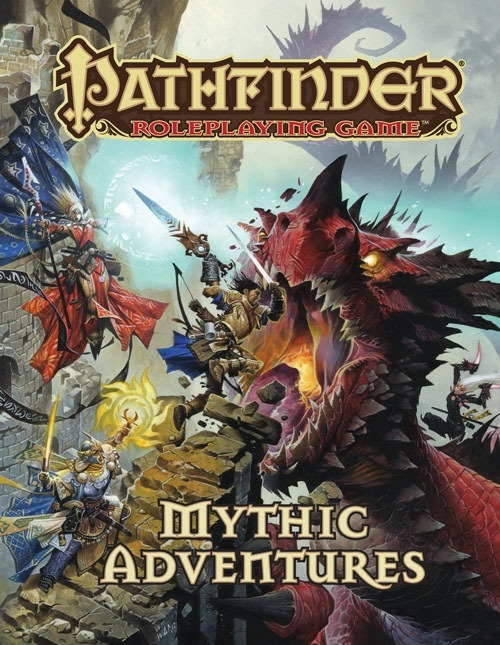
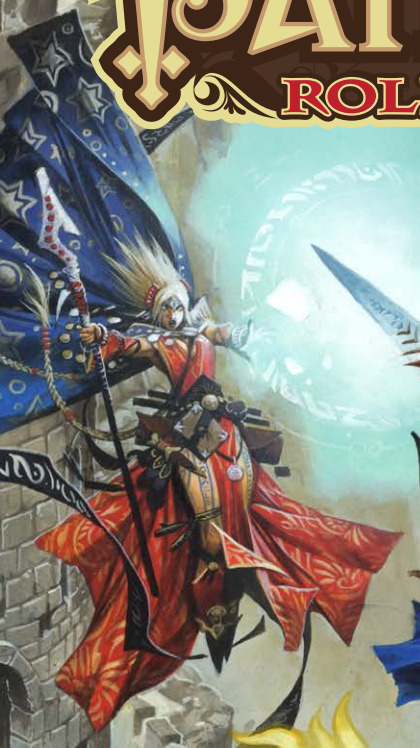
Wizard


Ezren (he/him, Human [Taldan], PF1 vs. PF2)
And last but not least, we have the Iconic Wizard, Ezren. Just like Kyra, Sajan and Harsk, the glow-up really made his robes vibrant, and I love that he's now showing off a little magic for us. His walking cane was upgraded to a staff, but it still has the iconic head. PF1 Ezren carries a crossbow, since in that game low-level magic was incredibly weak and spellcasters often needed a crossbow as a backup weapon. (somebody pointed out to me after I published this post that PF2 does still wear a crossbow on his right hip, don't know how I didn't notice that before)
12 notes
·
View notes
Text
My latest blog post from the cosy dragon: Guest Post: Robert Eggleton on ‘Reality-Based Inspiration’
IGuest Post with Robert Eggleton
Robert Eggleton has served as a children’s advocate in an impoverished state for over forty years. He is best known for his investigative reports about children’s programs, most of which were published by the West Virginia Supreme Court where he worked from1982 through 1997, and which also included publication of models of serving disadvantaged and homeless children in the community instead of in large institutions, research into foster care drift involving children bouncing from one home to the next — never finding a permanent loving family, and statistical reports on the occurrence and correlates of child abuse and delinquency.
Today, he is a retired children’s psychotherapist from the mental health center in Charleston, West Virginia, where he specialized in helping victims cope with and overcome physical and sexual abuse, and other mental health concerns. Rarity from the Hollow is his debut novel. Its release followed publication of three short Lacy Dawn Adventures in magazines: Wingspan Quarterly, Beyond Centauri, and Atomjack Science Fiction. The Advance Review Copy of Rarity from the Hollow received considerable praise through Robert learning about the world of books as a novice. The final edition was released to Amazon on December 5, 2016. Author proceeds have been donated to a child abuse prevention program operated by Children’s Home Society of West Virginia. http://ift.tt/1G6nS6o Robert worked for this agency in the early ‘80s and stands by its good works. He continues to write fiction with new adventures based on a protagonist that is a composite character of children that he met when delivering group psychotherapy services. The overall theme of his stories remains victimization to empowerment.
Rarity from the Hollow
Lacy Dawn’s father relives the Gulf War, her mother’s teeth are rotting out, and her best friend is murdered by the meanest daddy on Earth. Life in the hollow is hard. She has one advantage — an android was inserted into her life and is working with her to cure her parents. But, he wants something in exchange. It’s up to her to save the Universe. Lacy Dawn doesn’t mind saving the universe, but her family and friends come first.
The Past is the Past Reality-Based Inspiration in Fiction
Originally rejected by elitist publishers, George Orwell’s Down and Out in Paris and London (1933), semiautobiographical, is still regarded as one of fiction’s most inspiring works. The Cancer Ward by Alexander Solzhenitsyn (1967) similarly inspired people concerning a disease that continues to devastate families worldwide. Separated by decades, what do these two books have in common? In addition to great writing styles, the technique used to inspire readers is similar. There are many other examples of books that inspire by: if you think that your life sucks, read this. It will make you feel better. This book helps you appreciate what is going right in your life because what’s going on in the lives of the lives of characters in the story is awful.
Several notches above listening to an inspirational speaker selling a get-rich scheme, such as was once popular in real estate, other books reach for human drive and ambitions to inspire. How to Win Friends and Influence People by Dale Carnegie (1938) is the best selling self-help book of all time. A cornerstone was its wisdom on how to increase earning power – you can influence the behavior of others by how you behave toward them. A son of a poor farmer, Carnegie’s success (except in marriage) made fiction writers of millions of people in their relationships with others. As a former door-to-door Amway salesperson during college, attitudes and skills shared by Carnegie did prove effective in me paying for my books and tuition. I became a master of the compliment, heartfelt or not. Yes, we can become inspired to achieve material success.
Not counting the thousands of other great books which have inspired us to diet, eat more nutritionally…, one of my personal favorite inspirational books was The Art of Happiness (1998) by Dalai Lama. In contrast to books that inspired pursuit of materialism, this one encouraged us to reflect on our inner selves and to find out what happiness truly means. It questioned whether material success equates with true happiness. I don’t know about you, but I have a hard time concentrating on self-reflection if I’m worried about paying the electricity bill. For those who have achieved financial security, and who have found that happiness is elusive despite wealth, books like this one have been successful even if many of the concepts promoted in them cannot be proven to be fact.
Of course, The Bible has inspired countless individuals worldwide. So have Shruti for believers of Hinduism, The Tripitaka for those holding faith in Buddhism, Tanakh – the Hebrew Bible, and several other religious texts. For me, while most familiar with Christianity, the inspirational technique employed is fear: to prevent one’s eternal damnation to everlasting Hell – comply with the scriptures.
Apparently, threats can be inspiring. Quite a few folks who post on Facebook seem to believe so. The principle religious text of Islam is the Qur’an. It would be impossible to count the number of hate posts in recent months that inspire people to vote for politicians and policies because if you don’t, in effect, Muslims will rape all white Christian women unless they marry them first during childhood – all supposedly found in this book.
Have I gotten off on a tangent? This article was supposed to be about inspiration in fiction. Before I consider addressing superheroes, John Wayne-type characters, and the G.I. Joes, please note that, depending on reader interpretation, there may be a fine line between fiction and nonfiction. I’ll stop there because I don’t want to offend any readers of this blog. And, because that was precisely my dilemma as I wrote my debut novel, Rarity from the Hollow. How could I inspire sensitivity to the plight of maltreated children without taking readers outside of their comfort zones?
All things considered, I knew that I didn’t want to: (1) write something so tragic that it merely promoted readers to be grateful that their own childhoods had not been filled with horror; (2) sell the prevention of child maltreatment based on the positive economic impact that it would have on society or as a tax deductible contribution; (3) promise people that they will feel better about themselves if they contribute to the prevention of child maltreatment; (4) threaten people with damnation if they ignore needful kids; (5) or, warn people that maltreated children will grow up to victimize others, such as increased crime, if they don’t do something to help them now. All that has been tried before and child victimization rates are going up: new federal data shows nearly 3-percent rise in child abuse.
On the other hand, I also didn’t want to draw a veil over such a huge social problem as child maltreatment when writing Rarity from the Hollow. Some Young Adult novels that I’ve read, authors address childhood maltreatment without pulling a single one of my heart strings. Yes, there are wonderful books for children similar to Bobby and Mandee’s Good Touch / Bad Touch by Robert Kahn (2011), but as a retired children’s psychotherapist determined to write a novel that could potentially impact social policy, I knew that my book wouldn’t target children or even teens consumed with plot-driven escapist fiction.
I decided that Rarity from the Hollow would sensitize and inspire adult readers who were not prudish, faint-of-heart, or easily offended. I later realized, as the Advance Review Copy of my novel was being circulated, this designation carried an unintended message about my story to some potential readers and book reviewers – that it contained heavy sexual or violent content. Before the release of the final edition of my novel to Amazon on December 5, 2016, I wrote an article that was published on a book blog in an effort to clarify its content.
I’m a retired children’s psychotherapist. While participating with the editor on the final edition, as mentioned above, I sure had collected a bunch of elements that I didn’t want to portray in my debut novel. Most of the writing had been done after coming home drained from having worked at the local mental health center all day. Exhausted, at some point I made a very inspirational decision for me. Half of author proceeds are donated to the prevention of child maltreatment. http://childhswv.org I’m not sure if this aspect of the project has inspired others, but it did the trick for me.
Rarity from the Hollow uses soft science fiction as a backdrop, but has elements of other genres: fantasy, everyday horror, a ghost — so it’s a little paranormal, true-love type romance, mystery, and adventure. The content addresses social issues: poverty, domestic violence, child maltreatment, local and intergalactic economics, mental health concerns – including PTSD experienced by Veterans and the medicinal use of marijuana for treatment of Bipolar Disorder, Capitalism, and touches on the role of Jesus: “Jesus is everybody’s friend, not just humans.”
Several book reviewers have commented that the story is unique. Here’s one: “…soon I found myself immersed in the bizarre world… weeping for the victim and standing up to the oppressor…solace and healing in the power of love, laughing at the often comical thoughts… marveling at ancient alien encounters… As a rape survivor… found myself relating easily to Lacy Dawn… style of writing which I would describe as beautifully honest. Rarity from the Hollow is different from anything I have ever read, and in today’s world of cookie-cutter cloned books, that’s pretty refreshing… whimsical and endearing world of Appalachian Science Fiction, taking you on a wild ride you won’t soon forget….”
I selected science fiction as the backdrop because it was the best fit by process of elimination. The way I see it, the systems in place to help maltreated children are woefully inadequate. I felt that the straight literary, biographical, exposé, memoir, or nonfiction genres wouldn’t work because the story would have been so depressing that only the most determined would have finished it.
I felt that Rarity form the Hollow had to be hopeful. I wanted it to inspire survivors of child maltreatment toward competitiveness within our existing economic structures, instead of folks using past victimization as an excuse for inactivity – living in the past. I didn’t think that anybody would bite on the theme of a knight on a white stallion galloping off a hillside to swoop victims into safety, like in the traditional romance genre. That almost never actually happens in real life, so that genre was too unrealistic as the primary. There was already enough horror in the story, so that genre was out too. What could be more horrific than child abuse?
Readers who are used to the fantastical may feel less inspired about my bottom line to achieve a HEA ending for Rarity from the Hollow. While I don’t want to spoil anything for prospective readers, and I don’t think that this will, in the spaceship on their way home after saving the universe, Lacy Dawn’s father asks her, “Will you ever forgive me?” She answers, “No, but I will always love you.” Such is the optimal resolution of real-life child maltreatment cases. While it may never be forgotten or forgiven, the ability to put the past in the past and to move on with our lives regardless of the pain that we all have suffered from time to time, is the key to achieving true inspiration in fiction and in life.
from http://ift.tt/2pWMQrV
0 notes